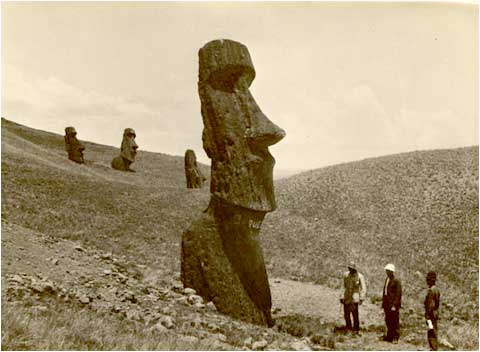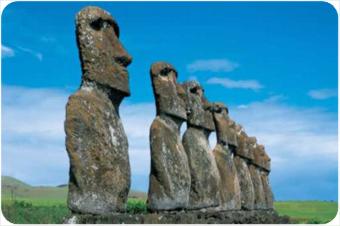Essentially all of the world’s leading scientists agree that, unless the human race makes significant changes to its use of this planet’s limited resources, we will cause such extensive and irreparable damage to the environment that it will destroy our civilization. Despite this, we continue to buy gas guzzling cars, develop the undeveloped, and cut down forests at an alarming rate; there is a long list of environmentally hostile practices we conduct without much hesitation. Even more difficult to understand is that this occurs when we have all been warned, both by science and incidents throughout our history. The reluctance of today’s modern society to take action and resolve the environmental problems we know exist stems from early humans’ relationship with the natural environment and its abundant resources. There are several factors involved: a) Humans have lived in an environmentally friendly manner up until 10,000 years ago which is yesterday in terms of evolutionary time. b) Even when humans did begin to use resources at an unsustainable rate, there have usually been other places to find more. c) In the past, our technology has helped us avoid many of the consequences of our actions; perhaps we assume that they will save us again. The human race has never been taught a lesson or suffered consequences of enough significance to spur us to change.
Human societies consisted entirely of hunter-gatherer groups up until the introduction of agriculture approximately 10,000 years ago. Food, wood, and other natural resources on which they depended were limited. As a result, there was no significant surplus to support a growing population with growing demands; lack of technology also made it difficult to obtain surpluses. The limitations of a local region’s resources encouraged the preservation of natural resources; humans collected from their environment only what was needed to survive. The limited availability of food kept populations relatively small and dispersed across large areas. This kind of distribution would resemble any other animals’ spatial placement; the population density was restricted by the amount of resources available locally. Only with the advent of agriculture would the distribution of humans around the world have stopped resembling that of other animals; food surpluses unobtainable in the hunter-gatherer life style allowed population densities to increase.
The significance of the hunter-gather lifestyle is that it was the sole mode of survival throughout essentially all of human evolutionary history; this time period can be extended as far back as two million years ago. Because the agricultural revolution occurred very recently in evolutionary time (~10,000 years ago), humans actually evolved without the awareness that resource use can have long-term effects. The spread of agriculture was a cultural revolution that natural evolution had no time to react to. We, like our hunter-gather ancestors, are not naturally aware of the dangers of resource over-use, and, as a result, began abusing our environment with our technology thousands of years ago and have continued ever since.
The few hunter-gatherer communities that exist today still embrace a lifestyle that discourages the over-use of local resources. Such communities tend to devote relatively little time to the collection of food despite the remote and often harsh conditions they live in. The Kung bushmen that inhabit a few isolated parts of Africa spend only several hours a day on food collection; the rest of their time is for leisure and traditional rituals, neither of which require the over-consumption of their limited local resources. This life is facilitated by the overwhelming sense of community and togetherness that has become entirely absent from modern culture. Essentially everything in these communities is shared including food and personal possessions, most of which can be easily made. Such a society leaves no place for the development of materialistic values that drive the use of resources unnecessary to survival. Only with the agricultural revolution spreading across the globe did human society begin to change in a manner that would eventually lead to abuse of the natural environment. With agriculture came food surpluses, higher population densities, and more “complex” societies. As a result, the high value of community wellness that seems to be universally characteristic of hunter-gatherer societies steadily gave way. The specialization of labor inherent in more complex societies produced possessions that likely fostered the beginnings of materialism. The introduction of this concept was a setback with regard to humans using natural resources in a sustainable manner.

A famous example of these concepts is the history of Easter Island’s inhabitants. Although the inhabitants of this island never necessarily lived in a hunter-gatherer lifestyle, their history shows clearly how more advanced societies can destroy the resources on which they depend to survive. The ability of the Easter Islanders to even establish themselves in an environment so isolated and limited with natural resources is a testament to their intelligence and resourcefulness. Nevertheless, it was the development of complexity in their culture and society that led to their destruction. First, the cultivation of sweet potatoes and raising of chickens allowed for their population to grow from what was initially a group of less than 50 people to a peak of almost 7,000 souls. This population growth was a consequence of an advanced, agricultural society; hunting and gathering would not have enabled such growth and, therefore, probably would have saved the Easter Islanders had it been their way of life.
Furthermore, the islanders spent much of their time constructing elaborate monuments and statues; this was also a huge drain on the already strained resources available on the small island. Without harnessed animals, hundreds of tree logs must have been required to move around the large slabs of stone used to build their structures. In the end, deforestation of the entire island degraded available resources to such an extreme that the entire island society began to steadily decline. Trapped on an island, the once great island civilization declined, over generations, into a state of barbarism and cannibalism.
 The history of Easter Island also relates to another important factor in the way humans have inhabited this earth. Once the resources of the island had been depleted, there was nowhere for the islanders to escape; however, this was not true for most other societies. When not on an island or barricaded by some other natural barriers, humans who have drained their local environment of resources have always been able to move into new, untouched areas. This fact certainly did not contribute to human awareness of resource abuse as we evolved but merely taught us that living in a sustainable manner was unnecessary.
The history of Easter Island also relates to another important factor in the way humans have inhabited this earth. Once the resources of the island had been depleted, there was nowhere for the islanders to escape; however, this was not true for most other societies. When not on an island or barricaded by some other natural barriers, humans who have drained their local environment of resources have always been able to move into new, untouched areas. This fact certainly did not contribute to human awareness of resource abuse as we evolved but merely taught us that living in a sustainable manner was unnecessary.
In addition, technological advances have also provided a means for escape when we have degraded or destroyed resources. In order to feed growing populations too large for the region they dwell in, many advances in food production have not only sustained growth but allowed it to continue. The arrival of tractors and artificially produced fertilizers have both staved off what had seemed to be unavoidable famine in the past. Currently, genetically modified crops appear to be the answer for the still growing world population.
Unlike other organisms whose populations are kept in check by the limits of local resources, the human population has never stopped growing or expanding. Humans have not received consequences of any significance for our over consumption. Even now, when we have all been notified by science of the imminent danger in which we are placing the world, we refuse to become truly aware of our actions. Throughout the majority of humans’ time on earth, their reserved, nomadic lifestyle did not strain the environment. When we did begin to strain the environment with agriculture and the demands of more complex societies, there were always more resources to consume or technological answers to the problems we caused. Early humans’ relationship with the natural environment and its seemingly endless resources have led to the difficulty of convincing today’s society that we are nearing the point of no return in preventing our planet from becoming another Easter Island.
Sources
Ears of Plenty. The Economist, December 24, 2005.
Paul Ehrlich NPR interview, October 27, 2000.
Ponting, Clive. Ninety-nine Percent of Human History. In: A Green History of the World. St. Martin’s Press, New York, pp.18-67
Ponting, Clive. The Lessons of Easter Island. In: A Green History of the World. St. Martin’s Press, New York, pp.1-7
Images
Amazing Peru – Travel Agency & Tour Operator: Amazing Chile. Last updated February 11, 2006. <http://www.amazingperu.com/peru/others_countries/chile/chile_tours/rapanuitour.asp>
Carnegie Institute of Washington. Voyages: Easter Island. Accessed February 11, 2006. <http://carnegieinstitution.org/legacy/exhibits/ault_exhibition/easter_island_head.html>